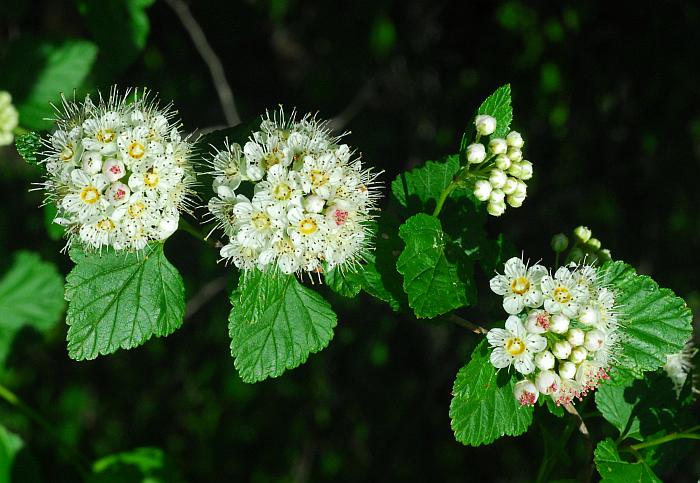Physocarpus opulifolius (L.) Maxim.
Ninebark

Native
CC = 5
CW = -3
MOC = 69
© SRTurner
Physocarpus opulifolius (L.) Maxim.Ninebark | |
 |
Native CC = 5 CW = -3 MOC = 69 |
© SRTurner |
|
Family - Rosaceae Habit - Shrub, sometimes suckering from roots. Stems - Ascending, to 2 m, unarmed. Bark brown, peeling in thin layers. Young stems green, angled.
Leaves - Alternate, petiolate, the petioles glabrous. Stipules 2-6 mm long, scalelike, linear to narrow oblong, pubescent with stellate hairs, deciduous. Leaf blades 1-6 cm long, simple, unlobed or more commonly 3-lobed, ovate to kidney-shaped, the margins doubly (finely and more coarsely) toothed, the upper surface glabrous, the undersurface glabrous or sparsely stellate-hairy, especially along the veins.
Inflorescences - Clusters, usually short racemes appearing umbellate, at the tips of branches, produced after the leaves mature, the flower stalks stellate-hairy, the flowers with a small stipulelike bract at the stalk base.
Flowers - Sepals 5, 2.0-3.5 mm long, reflexed to loosely ascending at flowering, triangular, the surfaces stellate-hairy, persistent at fruiting. Flowers perigynous, the hypanthium shallowly cup-shaped, with a prominent yellow nectar ring, stellate-hairy on the outer surface. Petals 5, 4-8 mm long, broadly obovate or elliptic, white. Stamens numerous, the anthers red when fresh. Pistils 3-5, sometimes fused toward the base. Ovary superior, usually densely stellate-hairy, with 1 locule and 2-4 ovules. Styles 1 per pistil, the basal portion persistent, the stigma capitate.
Fruits - Follicles, ascending, 4-10 mm long, elliptic-ovate in outline, abruptly narrowed to a slender beak, sparsely to moderately stellate-hairy, tan to brown and leathery to papery at maturity, 1-4-seeded. Seeds 1.8-2.5 mm long, asymmetrically ovoid, the surface hard, smooth, yellow, shiny.
Flowering - May - June. Habitat - Streambanks, forest margins, ledges, roadsides. Origin - Native to the U.S. Other info. - This attractive species is found in the southeastern 2/3 of the state. The North American distribution of var. intermedius, which includes Missouri's plants, comprises several rather disjunct populations ranging from Canada to Arkansas and from Colorado to Indiana. The var. opulifolius is more northeastern in distribution, and differs mainly in its glabrous fruits. Photographs taken at Darvin's Woods, Madison County, MO, 4-23-2012; St. Joe State Park, St. Francois County, MO, 5-13-2015; Valley View Glade Natural Area, Jefferson County, MO, 5-18-2010 and 5-8-2017; and Danville Conservation Area, Montgomery County, MO, 5-15-2018 (SRTurner). |